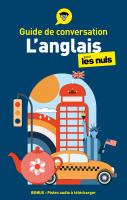Téléphoner en anglais : les bases pour comprendre et être compris par son interlocuteur (in english)
 31 janv. 2020
31 janv. 2020
 Pour les Nuls
Pour les Nuls
The telephone is great (very convenient) for any discussion with people we already know, because the sound of a familiar voice causes us to see a person in our mind’s eye, which our memory and our imagination supply with an animated picture in keeping with (reflecting) the evolution and the tone of the conversation.
In professional life however, most phone conversations take place between persons who haven’t met, but tacitly agree to speak together for a specific purpose. For the exchange to be satisfactory, something must be done to compensate for the fact that the talkers don’t know and don’t see each other. A ritual has emerged that applies equally to all kinds (sorts) of professions and situations. Following it goes a long way towards the efficient use of the telephone.
Répondre au telephone
Anyone answering a call in a professional context should have three goals in mind:
- Make a good first impression on the caller
- Learn who is calling
- Identify the motive of the call
In the following sample answer, the person sitting next to a ringing phone smiles, lets it ring twice, then picks it up:
“Good afternoon, dental surgery John Smith, Doctor Smith’s assistant Judith Barn speaking, how can I help you (what can I do for you)?”
The caller appreciates (is glad) not to have to wait more than two ringing tones, to be greeted by a smiling person, then have confirmation that he or she has reached the right place. The smile is not visible but is pictured in the caller’s mind thanks to the friendly tone of the answer. Hearing Judith Barn give her first and second name, the caller might automatically do likewise (do the same thing).
From that moment on, the ice is broken. The exchange can proceed rapidly on a sound basis. If the caller is in pain after a recent intervention by Dr Smith, Judith might say:
“Please hold on a moment, Ms Breakwater, I’ll ask Dr Smith”
Judith comes back with a tentative solution one minute later:
“Ms Breakwater? Thank you for holding (waiting). The doctor is with a patient and cannot take your call. He says your symptoms are typical of a wisdom tooth extraction and no cause for alarm. Take three tablets of Marstakin 500 as marked on your prescription and is it doesn’t work for you, ring us again and the doctor will prescribe a more potent painkiller (pain reliever).”
Appeler
When initiating (giving) a call, the caller should always first return the greetings of whoever answers, then state the motive of the call in a polite and concise manner.
- “Good morning. I’d like to speak to Gerald Hammersmith. I’m a friend of his, Jim Bourgeois.”
- “Good afternoon. My name is Mortimer Dupont. I’m writing an article for the Bonesticktown News about the proliferation of blackjack beetles in our county. I’ve heard about your success with organic products to eradicate some other pests and I need more detailed information on the subject. Could you please tell me who I might talk to?”
Déroulement et fin d’un échange téléphonique
Once a business conversation is initiated on the phone, it is important to bring os speedily (rapidly, swiftly) to a positive conclusion for both sides. When the persons know each other, or are discussing a situation that is of interest for both parties, this goal is easily achieved. In other cases, the caller and his or her counterpart should strive at the initial stage of the call for (endeavour at the initial stage of the call to achieve) a shared (common) understanding of its purpose. The conversation can then proceed smoothly, paying attention to a few simple rules.
- Be polite. Say please and/or use a modal such as may I, could you please, would it be possible to, would you mind if we…
- Make sure you understand and are understood. Factual data such as names, places, numbers can be securely exchanged, by repeating what you’ve heard to allow for correction, and if necessary, asking the other person to spell certain word: I’m not sure I got it right, could you please say that again? And how do you spell (your, this, her, his, it’s that) name? Could you please spell it for me?
- Before ending the conversation, it is essential to recap its main points and results so that both parties memorise them in the same way. Otherwise, the exchange may do more harm than good, raising expectations that won’t be fulfilled, breeding suspicion and rancour: Good, so you’ll e-mail us to confirm your agreement on a 10 percent rebate from your list price for a shipment of 58 broondicks to be delivered to our factory before the end of next month. But this is not all. The calling party should thank the other party, say goodbye and wait for his or her goodbye in response before hanging up.






























